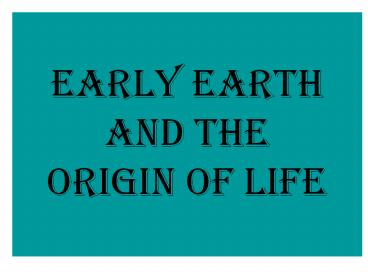EARLY EARTH PowerPoint PPT Presentation
1 / 62
Title: EARLY EARTH
1
EARLY EARTH and the ORIGIN OF LIFE
2
Major Episodes
Isotopes of carbon
3
- Life on Earth 3.5-4.0 billion years
- Prokaryotes 3.5 billion
- stromatolites
- Oxygen 2.7 billion
- Cyanobacteria
- Eukaryotes 2.1 billion
- Multicellular Eukaryotes 1.2 billion
- Animal Diversity Cambrian period
- Land plants 500 million
4
Cambrian Explosion
5
- THE ORIGIN OF
- LIFE
- Spontaneous
- generation
- Biogenesis
- Louis Pasteur
6
Miller Urey
- Primitive
- Atmosphere
- H2O
- H2
- CH4
- NH3
- Formation of organic monomers first
step in origin of life
7
- RNA may have been the first self replicating
genetic material. - Replication ribozymes (RNA autocatalytic)
- Natural selection (genotype phenotype)
8
PROTOBIONTS aggregates of abiotically
produced molecules
liposome
9
RNA template for polypeptide formation
Polypeptides act as primitive enzymes that aid
replication of all RNA molecules,
including competing RNAs
10
FIVE KINGDOM SYSTEM
11
Kingdom Characteristics must know!
12
PROKARYOTESAND THE ORIGINS OF METABOLIC
DIVERSITY
13
PROKARYOTES
extremophiles
eubacteria
14
STRUCTURE FUNCTION
- Shape cocci (spherical), bacilli (rod), spirilla
(helical) - Diplo- (2), strepto- (chain), staphylo- (cluster)
- Peptidoglycan (modified sugars cross-linked by
short polypeptides) in cell walls - Gram stain Gram (simpler walls, thick
peptidoglycan) Gram- (more complex, less
peptidoglycan) - Capsule protective layer outside wall, sticky
- Pili surface appendages
15
(No Transcript)
16
Motility flagella, spirochetes (corkscrew,)
slimy threads Taxis movement toward or away
from stimulus
17
ORGANIZATION REPRODUCTION
- Specialized membranes
- Nucleoid region
- Plasmids
- Binary fission
- Transformation
- Conjugation
- Transduction
- Endospores
- Antibiotics
18
(No Transcript)
19
- Nutritional Diversity
- Saprobes
- Parasites
- Metabolism of petroleum
- Nonbiodegradable (synthetic organic compounds)
- Nitrogen Metabolism
- Nitrogen fixation
- N2 ? NH4
- Cyanobacteria
Oxygen use Obligate aerobes Facultative
anaerobes Obligate anaerobes
20
(No Transcript)
21
- EXTREMOPHILES
- Methanogens
- Extreme halophiles (bacteriorhodopsin
- Extreme thermophiles
22
(No Transcript)
23
(No Transcript)
24
ECOLOGICAL IMPACT
- Decomposers
- Symbiosis
- Mutualism
- Commensalism
- Parasitism
- Pathogenic
- Kochs Postulates
- Exotoxins
- Endotoxins
- Bioremediation
25
(No Transcript)
26
THE ORIGINS OFEUKARYOTIC DIVERSITY
27
(No Transcript)
28
Characteristics
- Eukaryotic, unicellular, colonial, multicellular
- Nutrition aerobic, photoautotrophs,
heterotrophs, mixotrophs - Ingestive (protozoa), photosynthetic (algae),
absorptive (fungus like) - Motility flagella, cilia, psuedopodia
- Life cycles asexual (mitosis), sexual (meiosis
syngamy), cysts - Habitat aquatic (plankton) moist terrestrial
areas, contractile vacuoles
29
EUGLENA - MIXOTROPH
30
EVOLUTIONARY TRENDS 1) Filamentous Cyanobacteria
specialized cells 2) Complex communities
species w/ metabolic specialties 3)
Compartmentalization within cells ? eukaryotes
ENDOSYMBIOSIS
31
PRIMARY SECONDARY ENDOSYMBIOSIS
32
(No Transcript)
33
(No Transcript)
34
(No Transcript)
35
(No Transcript)
36
Diplomonadida and Parabasala
lack mitochondria
Giardia lamblia
Trichomonas vaginalis
37
Euglenozoa
- both photosynthetic and heterotrophic
flagellates
Euglena - mixotrophic
Trypanosoma African sleeping sickness
38
Alveolata
- unicellular protists with subsurface cavities
(alveoli) - Dinoflagellates red tides (deadly toxins)
Gonyaulax - Ciliates paramecium, stentor
- Apicomplexans all parasitic, plasmodium - malaria
39
(No Transcript)
40
(No Transcript)
41
(No Transcript)
42
Stramenopila
- The stramenopile clade includes the water molds
- and the heterokont algae
Oomycota Water mold
Diatoms glass like cell walls
Chrysophytes Golden algae
Phaeophytes brown algae, Seaweeds (kelps)
43
- SEAWEEDS
- Structural and biochemical adaptations help
seaweeds survive and reproduce at the oceans
margins - Food source, thickening agents, agar
- Some algae have life cycles with alternating
multicellular haploid and diploid generations
44
Rhodophyta Red algae lack flagella
Most abundant large algae in warm coastal
waters of tropical oceans
45
Chlorophyta
- Green algae and plants evolved from a common
photoautotrophic ancestor - Unicellular (chlamydomonas), colonial (volvox),
filamentous (spirogyra), multicellular (ulva) - Lichens
46
(No Transcript)
47
(No Transcript)
48
A diversity of protists use pseudopodia for
movement and feeding
Rhizopoda amoebas, amoebic dysentery
49
Actinopoda (Heliozoan Radiolarians)
Foraminiferans calcium carbonate walls, limestone
fossils, Dover cliffs
50
Mycetozoa Slime molds have structural
adaptations and life cycles that enhance their
ecological roles as decomposers
51
Plasmodial Slime Mold
52
(No Transcript)
53
FUNGI CHARACTERISTICS
- Eukaryotic
- Multicellular
- Heterotrophs (absorptive digestion outside
body) - Cell walls of chitin
- Classified by sexual stage (fruiting body)
54
Function obtaining food
55
Haustoria hyphae of parasitic fungi modified to
penetrate and absorb nutrients from host tissue
56
(No Transcript)
57
(No Transcript)
58
Example - Rhizopus
ZYGOMYCOTA
59
PENICILLIUM
ASCOMYCOTA
60
BASIDIOMYCOTA
61
LICHENS
MYCHORRHIZAE
Mutualistic Involve?
62
(No Transcript)

